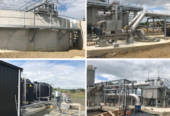
Economists might be predicting the house market will cool this year but for that to happen in Te Awamutu, Pirongia or Kihikihi, there would have to be “an awful lot more listings”, says real estate agent Vayle Hammond.

Vayle Hammond
CoreLogic’s Mapping the Market Report released this week showed the median house prices in those three Waipā communities had risen.
Pirongia was up 18.7 per cent to $812,150, Te Awamutu up 20.1 per cent to $714,100 and Kihikihi up 19.6 per cent to $667,550.
Meanwhile Cambridge has joined the million-dollar housing club and outside of six suburbs in Hamilton, has the highest median house value in the Waikato.
The median house price in Cambridge was $1,070,350, up 24.8 per cent on the previous year’s $857,350.
Leamington was up 24.1 per cent to $904,750.
Close Waikato district neighbours in Tamahere saw a 26.9 per cent increase to $939,550 while in Ōtorohanga and Te Kuiti, the median values were steady at $505,600 and $387,950.
 Cambridge has joined Harrowfield, Rototuna, Rototuna North, Flagstaff, Huntington, and Queenwood in the Waikato million dollar club.
Cambridge has joined Harrowfield, Rototuna, Rototuna North, Flagstaff, Huntington, and Queenwood in the Waikato million dollar club.
Median prices are calculated by taking the middle value when a data set is ordered from least to greatest.
The increases in and around Waipā have been fuelled by low mortgage rates, limited stock and Aucklanders moving south but those contributors are already changing, CoreLogic chief property economist Kelvin Davidson told The News.
“We can easily see a switch to a buyers’ market this year. There are very strong challenges coming – 2022 is going to be very different from 2021. I’m not saying house prices will fall though.”
For those who would struggle to sell and buy in the same market, another option would be to stay and invest in their property.
“Some people can’t move so they say, ‘I’m going to stay where I am and add that extra bedroom’.”
Top of those challenges are increased mortgage rates and a law change on December 1 which imposed tougher lending rules on buyers. Even those with pre-approved mortgages were finding banks are reviewing their offers, said one industry analyst.
First National Te Awamutu director Vayle Hammond said she was desperately short of listings.
“The change in the lending rules have made it difficult for some buyers,” she said.
One client had a pre-approval for $800,000 which had now gone down to $750,000.
People are moving to different towns. She recently sold a property in Te Kuiti to a buyer who saw it as more affordable and yet still close to Hamilton. Other trends were for people to buy “two bedders” rather that three to four bedroom houses.
“Last year everybody predicted a plateau but we would need an awful lot more listings for that to happen.”

Matt Henry
Forsyth Barr’s Waipā -based head of wealth management research Matt Henry said the New Zealand housing market now looks more vulnerable after several good years.
“We have some of the most unaffordable houses in the world,” he said.
Rental yields are lower than they used to be and with tax changes resulting in some clients being unable to claim depreciation, many investors were looking elsewhere to invest their money.
“You can understand why people felt comfortable about housing for many years,” he said.
It was safe and dependable.

Peter Tong
More-Re Real Estate director Peter Tong was unsurprised by Cambridge’s median price rise.
“Cambridge is a desirable destination particularly for Aucklanders,” he said.
“It’s going to be a different playing field this year and the banking changes have made it harder for first time buyers.
“But I’m still getting a lot of calls from Auckland. Our open homes were back this week and there are still people out there looking to buy,” said Tong.
Those struggling to buy in Cambridge or Leamington were looking in Te Awamutu and Putāruru.
“Generally, it’s around the greater Cambridge area.”
Tong said he was not seeing rental investors getting out of the market yet.
“Some landlords do have hearts and value their tenants.”









